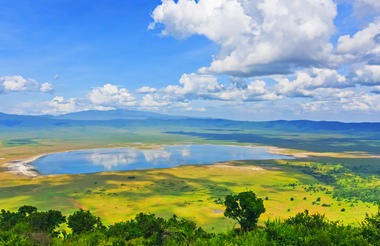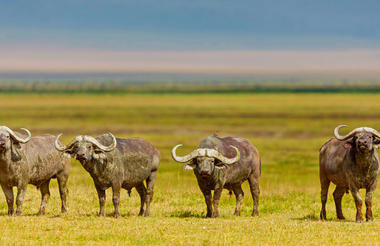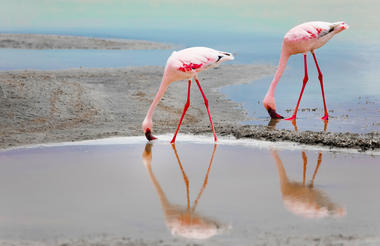You will be collected from your Arusha hotel by your private safari guide who will be escorting you on your private safari.
Enjoy a visit to Lake Manyara National Park. Nestled at the base of the Great Rift Valley escarpment, the park is noted for its incredible beauty. As visitors enter the gate, they pass into the lush forest, home to troops of baboons and both Blue and Vervet monkeys. Further along, the forest opens up into woodlands, grassland, swamps and beyond the soda lake itself, covering 200 square kilometres and sanctuary to over 400 species of bird including flamingo, pelican, stork, sacred ibis, cormorant and Egyptian geese. The park is particularly noted for herds of buffalo and elephant, as well as giraffe, hippo, reedbuck, warthog, wildebeest, zebra and a great variety of smaller animals.
Head up through the beautiful highlands to the farm rich area of Karatu on the outer slopes of Ngorongoro crater.
Overnight at Bougainvillea Lodge or similar.



Today starts with an early morning visit to one of the natural wonders of the world, the volcanic caldera of Ngorongoro , which offers spectacular game viewing in the crater. We can almost guarantee you four of the Big Five will show up, as well as a rich variety of birds, all viewed against the backdrop of the thickly forested crater walls. Varied terrains and dramatic landscapes consisting of forest, grasslands and both freshwater and soda lakes make the Ngorongoro Crater a true marvel of creation.
Continue onto the Ndutu region of NCCA (Ngorongoro Conservation Area)
The Serengeti/ NCAA region is home to more than three million large mammals spread over vast endless plains. It is here that we may encounter the fascinating spectacle of the annual wildebeest migration, where one and a quarter million wildebeest trek in columns of up to forty kilometres long in search of grazing, drawing with them their predators and numerous other species of game.
From January to March the herds can largely be found birthing their young in the southern area around Ndutu, before proceeding north through the centre and Western Corridor during June and July, eventually splitting to the west and north as they continue their way toward the Mara River. August to October sees dramatic river crossings which can only be considered Africa’s “greatest leap of faith”, before the herds return south in November to repeat this amazing instinctive procession all over again.
Overnight Ndutu Wilderness Camp for 3 nights



Morning transfer by road to Arusha/ Kilimanjaro Airport.
End of services




